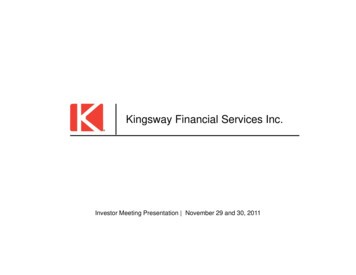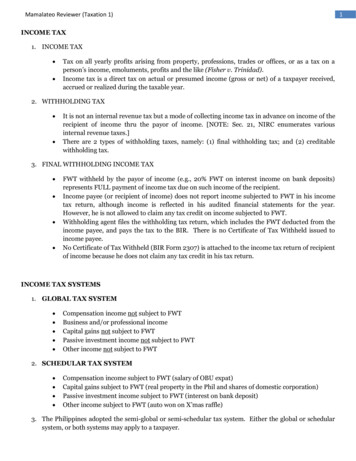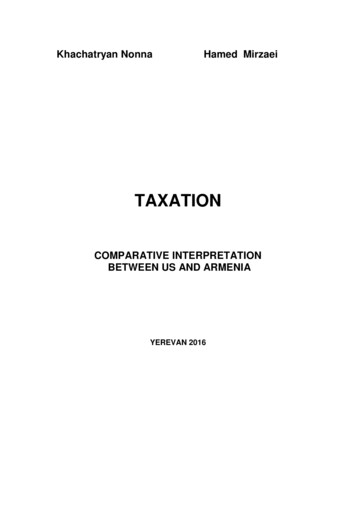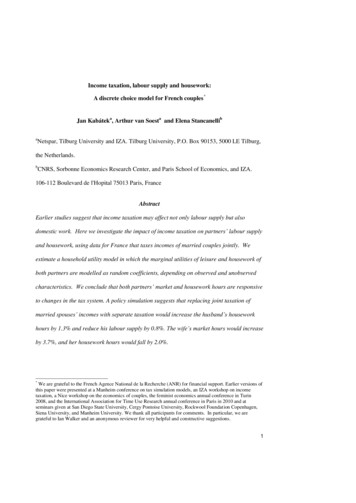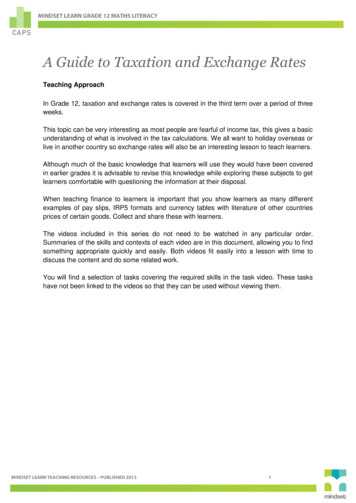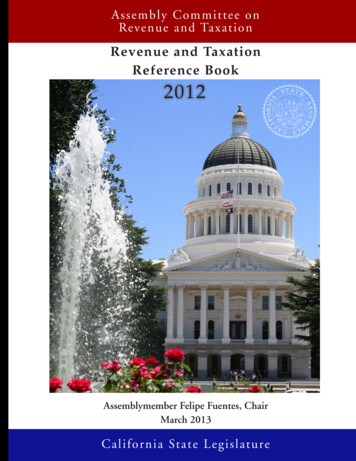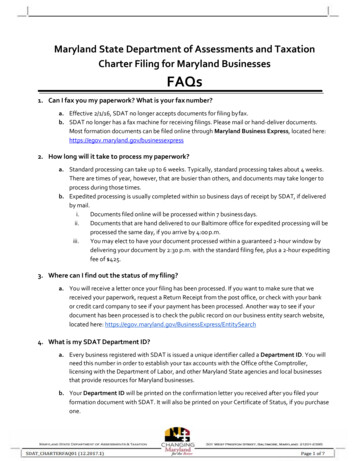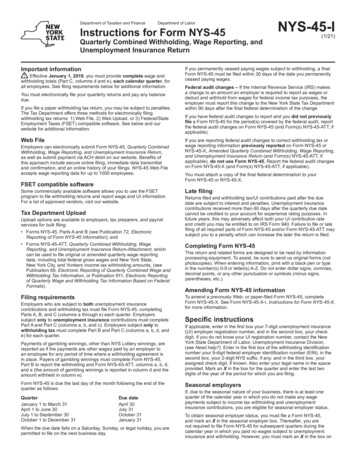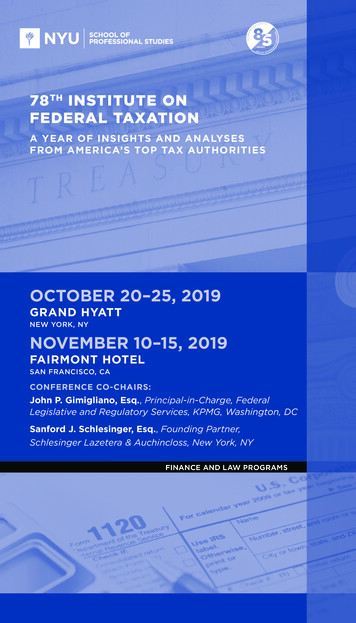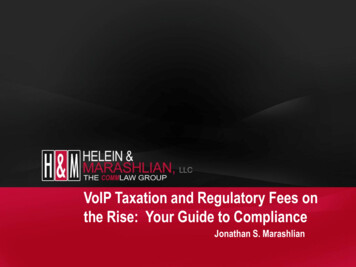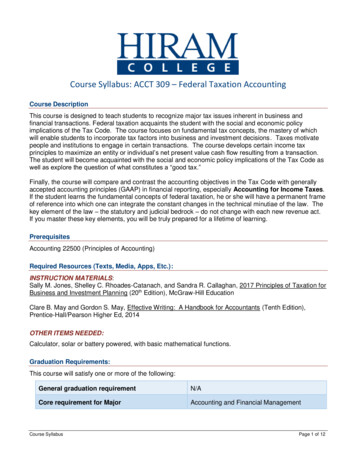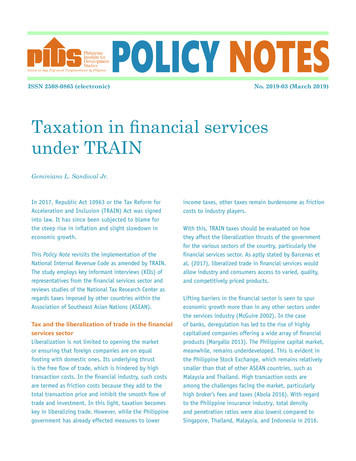
Transcription
ISSN 2508-0865 (electronic)No. 2019-03 (March 2019)Taxation in financial servicesunder TRAINGeminiano L. Sandoval Jr.In 2017, Republic Act 10963 or the Tax Reform forAcceleration and Inclusion (TRAIN) Act was signedinto law. It has since been subjected to blame forthe steep rise in inflation and slight slowdown ineconomic growth.This Policy Note revisits the implementation of theNational Internal Revenue Code as amended by TRAIN.The study employs key informant interviews (KIIs) ofrepresentatives from the financial services sector andreviews studies of the National Tax Research Center asregards taxes imposed by other countries within theAssociation of Southeast Asian Nations (ASEAN).Tax and the liberalization of trade in the financialservices sectorLiberalization is not limited to opening the marketor ensuring that foreign companies are on equalfooting with domestic ones. Its underlying thrustis the free flow of trade, which is hindered by hightransaction costs. In the financial industry, such costsare termed as friction costs because they add to thetotal transaction price and inhibit the smooth flow oftrade and investment. In this light, taxation becomeskey in liberalizing trade. However, while the Philippinegovernment has already effected measures to lowerincome taxes, other taxes remain burdensome as frictioncosts to industry players.With this, TRAIN taxes should be evaluated on howthey affect the liberalization thrusts of the governmentfor the various sectors of the country, particularly thefinancial services sector. As aptly stated by Barcenas etal. (2017), liberalized trade in financial services wouldallow industry and consumers access to varied, quality,and competitively priced products.Lifting barriers in the financial sector is seen to spureconomic growth more than in any other sectors underthe services industry (McGuire 2002). In the caseof banks, deregulation has led to the rise of highlycapitalized companies offering a wide array of financialproducts (Margallo 2013). The Philippine capital market,meanwhile, remains underdeveloped. This is evident inthe Philippine Stock Exchange, which remains relativelysmaller than that of other ASEAN countries, such asMalaysia and Thailand. High transaction costs areamong the challenges facing the market, particularlyhigh broker’s fees and taxes (Abola 2016). With regardto the Philippine insurance industry, total densityand penetration ratios were also lowest compared toSingapore, Thailand, Malaysia, and Indonesia in 2016.
Financial liberalization is very tricky. On one end,liberalization is necessary to increase competitionand introduce the Philippine market to other financialinstruments. On the other end is the need to managerisks in the system, as experience shows that bankingregulation by the Bangko Sentral ng Pilipinas hasinsulated the industry from external shocks. Hence, adelicate balancing is needed in regulating the financialsector. This is likewise true in the case of taxation.Table 1. Increase in taxes affecting the bankingsector under TRAINTransactionTax BaseOld RateNew RateInterest incomeAmount of interestfrom ForeignincomeCurrency DepositUnit7.50 percent 15 percentFixed amount onBank checks,drafts, certificates each documentof depositsnot bearinginterests, andother instruments(DST)PHP 1.50PHP 3.00Debt instruments(DST)For everyPHP 1.00PHP 200.00 and itsexceeding fractionPHP 1.50Bills of exchangeor drafts (DST)For everyPHP 0.30PHP 200.00 and itsexceeding fractionPHP 0.60Uponacceptance ofbills of exchange(DST)For everyPHP 0.30PHP 200.00 and itsexceeding fractionPHP 0.60Foreign Bills ofExchange andLetters of Credit(DST)For everyPHP 0.30PHP 200.00 and itsexceeding fractionPHP 0.60MortgagesWhen amountsecured does notexceedPHP 5,000.00PHP 20.00PHP 40.00On eachPHP 5,000 andfraction exceedingeveryPHP 5,000.00PHP 10.00PHP 20.00DST documentary stamp taxTRAIN Tax Reform for Acceleration and InclusionSource: Author’s compilation2 w Taxation in financial services under TRAINTaxation of financial transactions under TRAINBased on the result of KIIs, the change in rates of taxeson financial transactions has increased friction costs.In terms of wholesale investments, these taxes becomecrucial for investors in choosing jurisdictions to placetheir money or business.BankingIn the banking industry alone, taxes have gone up byas much as 100 percent (Table 1). In particular, thedocumentary stamp tax (DST), an excise tax levied onbanking documents, instruments, loan agreements,and papers, has increased across the board. Higher DSTmeans costlier financial transactions in the country. Itis charged to each transaction and increases transactioncosts and is thus viewed as a friction cost which coulddiscourage investors or inhibit the flow of trade.EquitiesAs to equities, stocks not traded in the stock exchangeare now uniformly taxed at 15 percent on capital gains.Prior to the TRAIN regime, their tax was only at 5 percentif the gain were PHP 100,000.00 or less and 10 percent ifover PHP 100,000.00. Meanwhile, taxes for stocks tradedin the stock exchange and not sold by a dealer haveincreased by 20 percent under TRAIN, from 1/2 to 6/10of 1 percent of the gross selling price (Table 2).InsuranceOn insurance transactions, TRAIN prescribes variousDST rates for life insurance policies as well as changedthe tax base, which moved from the effective rate of12 percent on the premium. However, it increased theeffective rate for preneed plans from 0.10 percent to0.20 percent and also doubled the DST for certificates ofdamages (Table 3).TRAIN taxes and ASEAN ratesThis study also examines the TRAIN taxes in light of therates prescribed by other ASEAN countries. This is not aquantitative or even qualitative assessment of the newrates of taxes, but a comparison of the rates imposed bythe Philippines and its ASEAN neighbors.
Table 2. Taxes affecting the sale of shares of stockunder TRAINTransactionTax BaseOld Rate5 percent if thegain were lessthan or equalPHP 100,000.00and 10 percent ifthe gain is overPHP 100,000.00New RateSale of stocksnot traded in thestock exchangeCapitalgains15 percentSale of stockstraded in thestock exchangeand not sold by adealerGross1/2 of 1 percentselling priceor value ofthe shares3/5 of1 percentSales,agreements tosell, memorandaof sales, anddeliveriesor transfersof shares orcertificates ofstocks25 percentDST onoriginalissue ofshares ofstock (stockwithout parvalue)50 percentDST documentary stamp taxTRAIN Tax Reform for Acceleration and InclusionSource: Author’s compilationBankingOnly the Philippines and Thailand collect DST or itsequivalent on letters of credit. The Philippines charges0.15 percent on face value of the letter of credit(Fronteras and Rempillo 2015). Meanwhile, Thailandimposes a tax of PHP 28.00 if the value of the letter ofcredit is less than PHP 13,900.00, or PHP 42.00 ifPHP 13,900.00 or higher (Fronteras and Rempillo 2015).Tables 4 and 5 show comparisons of other DST rates inthe Philippines against those charged by other ASEANcountries. While the DST imposed by the Philippinesappears to be reasonable, its rates have significantlyincreased under TRAIN. It is difficult to assess theimpact of these new rates on trade in financialservices because checks and bill of exchange may bemore relevant in the domestic sphere rather than ininternational trade.Table 3. DST on insurance under TRAINTransactionTax BaseOld rateNew rateLifeinsuranceOld:PremiumchargedNew: Amountof insurancePHP 0.50for everyPHP 4.00 orfractiona. Less thanPHP 100,000.00:Exemptedb. PHP 100,000–PHP300,000: PHP 20.00c. PHP 300,001–PHP 500,000:PHP 50.00d. PHP 500,001–PHP 750,000:PHP 100.00e. PHP 750,001–PHP 1,000,000:PHP 150.00f. Over PHP1,000,000:PHP 200.00PreneedplanOn eachspecificamount orits fractionof the totalvalue of theplanPHP 0.50for everyPHP 500 orfractionPHP 0.40 for everyPHP 200 or fractionCertificateof damageOn eachcertificatePHP 15.00PHP 30.00DST documentary stamp taxTRAIN Tax Reform for Acceleration and InclusionSource: Author’s compilationEquitiesBrokers and traders of equities may have cause to bediscouraged by the new rates of taxes imposed on thetrading of shares in the stock market. As pointed outearlier, the increase is as high as 20 percent, substantialin light of the taxes imposed by other ASEAN countries.In fact, most of our ASEAN neighbors do not impose atax on the transfer of shares (Table 6). Indonesia is oneexception, but its rate is but a small fraction of what thePhilippines charges.On sales of stocks, most ASEAN countries impose DSTor its equivalent (Table 7). However, given the differenttax bases of the Philippines and other ASEAN countries,a cost comparison is difficult to perform. If the tax baseis the par value, the comparison would be easier, as parPIDS Policy Notes 2019-03 w 3
Table 4. Sample DST imposed on the issuanceof checks in the ASEAN regionCountryTax BaseRatePhilippinesPer checkPHP 3.00Brunei DarussalamPer checkPHP 4.00IndonesiaPer value ofchecka. If below PHP 915.00:Exemptedb. PHP 915.00 toPHP 3,660.00: PHP 11.00c. If over PHP 3,660.00:PHP 22.00MalaysiaPer checkPHP 2.00SingaporeNonen/aThailandPer checkPHP 4.00ASEAN Association of Southeast Asian NationsDST documentary stamp taxSource: Fronteras and Rempillo (2015); Author’s compilationTable 5. Sample DST on bills of exchangein the ASEAN regionCountryTax baseRatePhilippinesFace value0.30 percentBrunei DarussalamSegmentedamount and foradditional fraction(PHP 4.00 for firstPHP 3,526.00 andPHP 4.00 for everyadditionalPHP 353.00 orfraction0.11 percent for firstPHP 3,526.00 and1.13 percent for theadditional amountFixed ratePHP 4.00 per billThailandASEAN Association of Southeast Asian NationsDST documentary stamp taxSource: Fronteras and Rempillo (2015); Author’s compilationTable 6. Sample of tax rates on sale of stocks tradedin the stock exchange in the ASEAN regionCountryTax BaseRatePhilippinesGross selling price6/10 of 1 percent or0.60 percentCambodiaExemptedn/aIndonesiaTransaction value0.10 percentMalaysiaExemptedn/aThailandExemptedn/aASEAN Association of Southeast Asian NationsSource: Nejar and Rempillo (2015); Author’s compilation4 w Taxation in financial services under TRAINvalue is fixed. Meanwhile, the market value of sharesmay go up and down and may even be below a share’spar value.InsuranceAmong the subsectors of the insurance industry, nonlifeinsurance was identified as the one heavily taxed.In fact, a significant portion of the cost of a nonlifeinsurance policy constitutes taxes imposed by thePhilippine government.While this may not be a friction cost to an investor,tax contributes to the high price of their product,which may inhibit the product’s growth in the market.The cost may drive down demand for nonlife insuranceand discourage the entry of investors in this particularsector. In the long run, this may have an adverse impacton the liberalization thrust of the government.Table 8 also reveals that the value-added tax (VAT)imposed by the Philippines is 71 percent higher than whatis imposed by Thailand. Meanwhile, other jurisdictions donot impose VAT on nonlife insurance products.The KII also revealed the private sector’s difficulty inentering into the crop insurance sector. Currently, thegovernment is heavily involved in the said sector andthe benefits are being poured into public institutions,such as the Philippine Crop Insurance Corporation(PCIC). Under Presidential Decree 1467, PCIC is exemptfrom taxes, which means PCIC would be able to provideservices at lower costs.A survey of taxes imposed by ASEAN countries alsoshows that life insurance is highly promoted in somejurisdictions. Moreover, insurance companies in certainjurisdictions enjoy reduced corporate income taxes. InCambodia, for instance, life insurance companies aretaxed at 5 percent on gross premiums (Jurado and Amurao2015). In Singapore, while life insurance companiesare taxed at 17 percent on their income like any othercompany, the policy holder enjoys the benefit of a taxrate on income of 10 percent (Jurado and Amurao 2015).
Table 7. Sample of DST or equivalent on salesof stocks in the ASEAN regionCountryTax BaseRatePhilippinesPar value0.75 percentBrunei DarussalamPar value1.13 percentCambodiaMarket value0.10 percentMalaysiaPrice on date oftransfer0.30 percentSingaporePurchase price ormarket value0.20 percentThailandPaid-up value ornominal value0.07 percentASEAN Association of Southeast Asian NationsDST documentary stamp taxSource: Fronteras and Rempillo (2015); Author’s compilationTable 8. Sample of VAT on nonlife insurancepolicies in the ASEAN regionCountryTax BaseRatePhilippinesGross premiums(except on cropinsurance)12 percentBrunei xemptedn/aMalaysiaExemptedn/a though Malaysiaimposes a 5-percentservice tax on thepremiumThailandGross premiums7 percentASEAN Association of Southeast Asian NationsVAT value-added taxSource: Jurado and Amurao (2015); Author’s compilation.Meanwhile, the Philippines does not differentiate lifeinsurance companies from any other firms and imposes atax of 30 percent on their net taxable income.Similar to the Philippines, other ASEAN countriesalso impose a standard corporate income tax on lifeinsurance companies. However, the Philippine corporateincome tax rate is the highest in the ASEAN region(Pabilona and Domo 2018). This means life insurancecompanies in the Philippines are subject to the highestincome tax in ASEAN.Table 9. S ample of DST or its equivalent imposedon life insurance in the ASEAN regionCountryPhilippinesTax BaseRateAmount of insurance Graduated rates withhighest rate at0.02 percentBrunei Darussalam Sum insured0.01 percentCambodiaExemptedn/aMalaysiaPolicy exceedingPHP 63,300(MYR 5,000.00)*PHP 126.60SingaporeExemptedn/aThailandSum insured0.05 percentViet NamExemptedn/a* Based on MYR to PHP exchange rate of PHP 12.66ASEAN Association of Southeast Asian NationsDST documentary stamp taxSource: Jurado and Amurao (2015); Author’s compilationWhile the Philippine DST rate may be described ascompetitive compared to rates imposed by other ASEANcountries, at least three ASEAN countries exempt lifeinsurance policies from DST (Table 9).RecommendationsThis study recommends a careful analysis of theimposition of taxes on financial services to preventunintended consequences. While taxes are meant to raisefunds for the government to pump prime the economy,they may also serve as discouragement to investors andbusinesses. These investors and businesses may turn tothe Philippines’ ASEAN neighbors instead, resulting inrevenue losses from annual income taxes. The thresholdfor participants in the market should be determined totest their preference for Philippine financial services.In certain respects, the comments expressed by certainsectors should be validated, as with the opposition to theincrease in the stock transfer tax by players in the equitiesmarket. In the KIIs, the taxes on the sale or transfer ofshares of stock were cited as one of the reasons for thedecline in the volume of stocks traded daily.The same is true for the insurance sector, where itsdevelopment and promotion are dampened by thePIDS Policy Notes 2019-03 w 5
concomitant taxes. Nevertheless, it is hard to assess theimpact of taxes on insurance vis-a-vis the rates imposedby neighboring states since insurance is not as easilytraded as equities and usually remains in its situs. Whatcould be measured is demand for insurance products andinvestments by insurance companies.Even removing the aspect of competition from thePhilippines’ ASEAN neighbors in attracting investments,taxation should still be assessed in terms of improvingthe Philippine tax system. One aspect of which isthe need to broaden the tax base (Pabilona andDomo 2018). If investors and businesses find taxeson transactions as burdensome costs and shun thePhilippines for friendlier jurisdictions, then the tax basewould not widen.Tax rates under TRAIN have significantly increased.Such increases, particularly on DST, may be acceptablein single transactions. However, from the businessstandpoint, the cost of completing a transactionor delivering their service has already doubled. Inwholesale investments, the increased costs accumulate,which may in turn reduce interest in the Philippines. Inthis regard, data on these sectors should be reviewed assoon as they become available.In conclusion, what is apparent at the moment isthat the increased taxes on the sale of equitiescontributed to the decline in the volume of trade.With ecommerce facilitating the transfer of funds inother markets, the effect on the Philippine equitiesmarket is immediately felt.Meanwhile, on insurance, the taxes have increased theprices of insurance products. Whether such increasesaffected trade or entry into the Philippines, the datashould be reviewed once they are consolidated. 4ReferencesAbola, V. 2016. Capital market development in thePhilippines. Nomura Journal of Asian Capital Markets1(1):18–26.Barcenas, L.A.B., G.T. Reyes, J.L. Tongzon, and R.B.Serafica. 2017. Regulatory measures affecting servicestrade and investment: Distribution, multimodaltransport, and logistics services. PIDS Discussion PaperNo. 2017-40. Quezon City, Philippines: PhilippineInstitute for Development Studies.Fronteras, L.C.B. and M.G. Rempillo. 2015. Comparativedocumentary stamp tax imposed by ASEAN countries.NTRC Tax Research Journal 27(2):31–41.Jurado, F.J. and M.B.L. Amurao. 2015. Comparative taxationof life and nonlife insurance in ASEAN countries. NTRCTax Research Journal 27(1):8–30.Margallo, R. 2013. Prospects for the regulation of thePhilippine financial sector in the medium term. MAthesis. Tokyo, Japan: University of Tokyo.McGuire, G. 2002. Trade in services – Market accessopportunities and the benefits of liberalization fordeveloping economies. Policy Issues in InternationalTrade and Commodities Study Series No. 19. NewYork, NY: United Nations Conference on Trade andDevelopment.Nejar, E.M.T. and Rempillo, M.G., 2015. Comparativefinancial transaction taxes imposed on the sale ofshares of stock listed and traded through the ASEANstock exchanges. NTRC Tax Research Journal 28(1):1–7.Pabilona, J.C.R. and R. Domo. 2018. Comparative corporateincome taxation in ASEAN member-countries. NTRC TaxResearch Journal 30(1):50–79.Contact usAddress:Telephone:Email:Website:Research Information DepartmentPhilippine Institute for Development Studies18/F Three Cyberpod Centris - North TowerEDSA corner Quezon Avenue, Quezon City( 63-2) 372-1291 to 92publications@mail.pids.gov.phwww.pids.gov.ph6 w Taxation in financial services under TRAINPIDS Policy Notes are analyses written by PIDS researchers on certainpolicy issues. The treatise is holistic in approach and aims to provideuseful inputs for decisionmaking.The author is a consultant at the Philippine Institute for DevelopmentStudies (PIDS). The views expressed here are the authors’ own. Theviews expressed are those of the author and do not necessarily reflectthose of the PIDS or any of the study’s sponsors.
entering into the crop insurance sector. Currently, the government is heavily involved in the said sector and the benefits are being poured into public institutions, such as the Philippine Crop Insurance Corporation (PCIC). Under Presidential Decree 1467, PCIC is exempt from taxes, which means PCIC would be able to provide services at lower costs.
